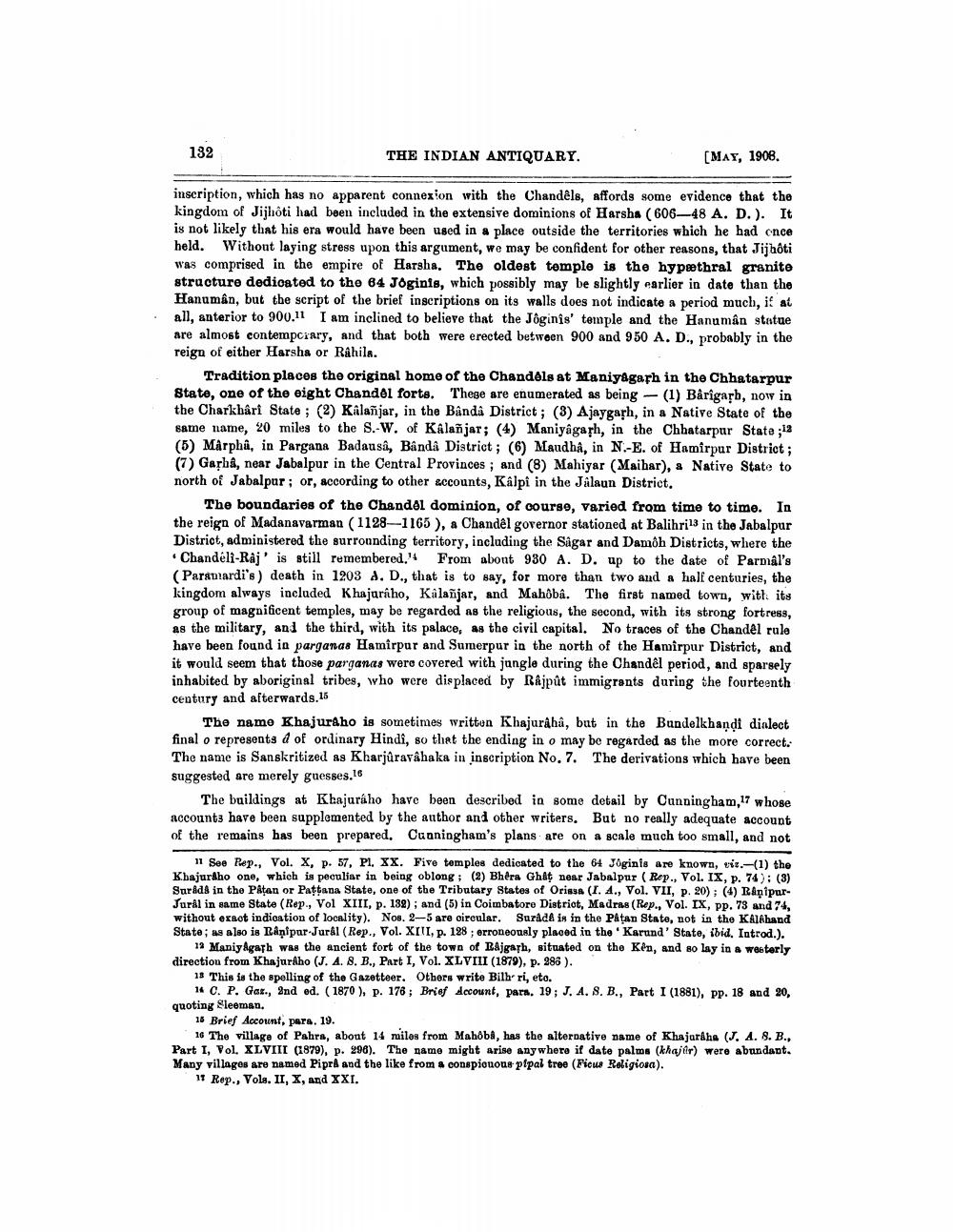________________
132
THE INDIAN ANTIQUARY.
[MAY, 1908.
inscription, which has no apparent connexion with the Chandêls, affords some evidence that the kingdom of Jijhoti had been included in the extensive dominions of Harsha (606-48 A. D.). It is not likely that his era would have been used in a place outside the territories which he had once held. Without laying stress upon this argument, we may be confident for other reasons, that Jijhôti was comprised in the empire of Harsha. The oldest temple is the hypethral granite structure dedicated to tho 64 Joginis, which possibly may be slightly earlier in date than the Hanuman, but the script of the brief inscriptions on its walls does not indicate a period much, if at all, anterior to 900.11 I am inclined to believe that the Jôginis' temple and the Hanuman statue are almost contempcrary, and that both were erected between 900 and 950 A. D., probably in the reign of either Harsha or Râhila.
Tradition places the original home of the Chandels at Maniyagaph in the Chhatarpur State, one of the eight Chandol forts. These are enumerated as being -- (1) Bårigarh, now in the Charkhâri State ; (2) Kalañjar, in the Banda District; (3) Ajaygarh, in a Native State of the same name, 20 miles to the S. W. of Kalañjar; (4) Maniyagarh, in the Chhatarpur State ;12 (6) Marpha, in Pargana Badausa, Banda District; (6) Maudha, in N-E. of Hamirpur District ; (7) Gapha, near Jabalpur in the Central Provinces; and (8) Mahiyar (Maibar), a Native State to north of Jabalpur ; or, according to other accounts, Kalpi in the Jalaun District.
The boundaries of the Chandel dominion, of course, Varied from time to time. In the reign of Madanavarman (1128--1165 ), a Chandel governor stationed at Balihri13 in the Jabalpur District, administered the surrounding territory, including the Sigar and Damoh Districts, where the • Chandeli-Raj' is still remembered." From abont 980 A. D. up to the date of Parmális (Paramardi's death in 1203 d. D., that is to say, for more than two and a half centuries, the kingdom always included Khajuraho, Kalañjar, and Mahoba. The first named town, with its group of magnificent temples, may be regarded as the religious, the second, with its strong fortress, as the military, and the third, with its palace, as the civil capital. No traces of the Chandel rule have been found in parganas Hamirpur and Sumerpur in the north of the Hamirpur District, and it would seem that those parganas were covered with jungle during the Chandel period, and sparsely inhabited by aboriginal tribes, who were displaced by Rajpût immigrants during the fourteenth century and afterwards.15
The name Khajuraho is sometimes written Khajuraha, but in the Bundelkhandi dialect final o represents d of ordinary Hindi, so that the ending in o may be regarded as the more correct. The name is Sanskritized as Kharjûraváhaka in inscription No. 7. The derivations which have been suggested are merely guesses.16
The buildings at Khajuraho have been described in some detail by Cunningham,17 whose accounts have been supplemented by the author and other writers. But no really adequate account of the remains has been prepared. Cunningham's plans are on a scale much too small, and not
11 See Rep., Vol. X, p. 57, Pl. XX. Five temples dedicated to the 64 Joginis are known, rit.-(1) the Khajuraho one, which is peculiar in being oblong; (2) Bhêra Ghát near Jabalpur (Rep., Vol. IX, p. 74): (3) Sarids in the Pâtan or Pattana State, one of the Tributary States of Orissa (I. A., Vol. VII, p. 20); (4) RapipurJuril in same State (Rep., Vol XIII, p. 182); and (5) in Coimbatore District, Madras (Rep., Vol. IX, pp. 73 and 74, without er et indication of locality). Nos, 2-5 are circular. Surada in in the Patan State, not in the Kalahand Stato; us also is Ranipar-Jurál (Rep., Vol. XIII, p. 128 ; erroneously placed in the Karund' State, ibid. Introd.).
19 Maniy Agath was the ancient fort of the town of Rajgarh, situated on the Kên, and so lay in a westerly direction from Khajuraho (J. A. 8. B., Part I, Vol. XLVIII (1879), p. 286 ).
13 This is the spelling of the Gazetteer. Others write Bilhrri, eto.
14 C. P. Gar., 2nd ed. (1870), p. 176; Brief Account, para, 19; J. A. 8. B., Part I (1881), pp. 18 and 20. quoting Sleeman.
16 Brief Account, pers. 19.
16 The village of Pahra, about 14 miles from Mahoba, has the alternative name of Khajaráha (J. 4. 8. B., Part I, Vol. XLVIII (1879), p. 296). The name might arise anywhere it date palms (khajir) were abundant. Many villages are named Piprl and the like from a conspicuous pfpal tree (Ficus Religiosa).
11 Rop., Yola. II, X, and XXI.




